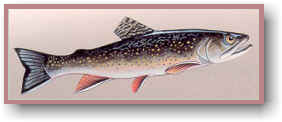
Brook Trout
Salvelinus fontinalis
Status
Native to Newfoundland and Labrador.
Habitat
Prefer habitat with a ph between 6.5 and 8.0. In streams they prefer bank and in-stream cover, and in lakes are partial to cold, clear waters.
Range
Occur in all provinces in Canada.
Food
Diet is extremely variable and may include insects, worms, mollusks, mice, and even their own eggs and young.
Appearance
Forked tail; olive to black above with black lines on tail fin; belly can be white to yellow in females or deep orange to red in males.
Breeding Biology
Spawning ranges from September to November. Preferred spawning areas are cool, clear headwater streams with clean, ventilated gravel in water depths of 61cm. Spawning is also possible in lakes, particularly in gravelly areas subjected to spring upwellings and moderate water currents.
During spawning females will dig a redd, or pit, in the gravel. One male is in attendance, but both sexes will drive out intruders. Both male and female Brook Trout mate with multiple partners during the spawning season. Eggs are large (3.5-5.0mm) and hatch in approximately 100 days. Larvae remain in the gravel until the yolk sac from which they feed has been totally absorbed. After emerging from the gravel, young Brook Trout prefer the quiet, shallow edges areas of streams and small brooks. These areas are often referred to as nurseries. Many of these small nursery brooks can be destroyed by human activity.
